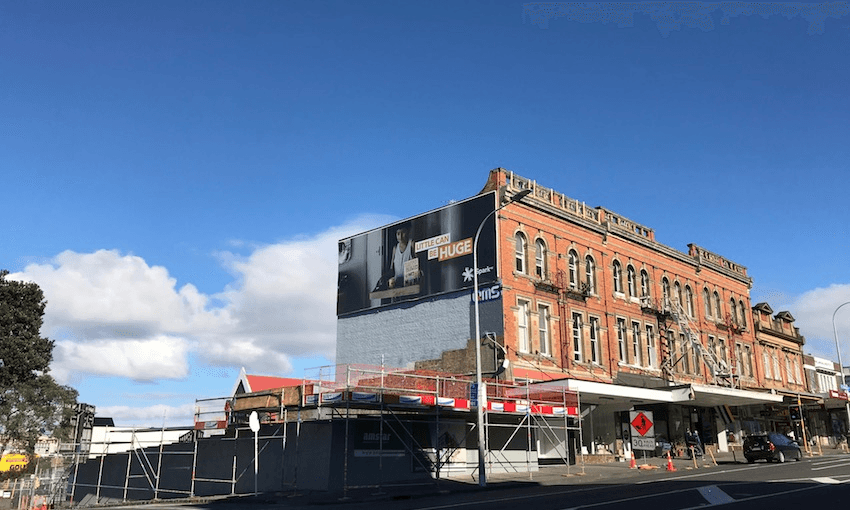Once Auckland’s retail centre, K’ Road was forever changed by the Western Motorway, but is on its way back to being a thriving retail centre where more and more people want to live. Henry Oliver went to look at one apartment building’s addition to K’ Road’s continual evolution.
The ‘real’ Karangahape Road – like the ‘real’ New York or the ‘real’ London – is the one you first walked along or lived on. For developer Mark Cooper, it was living in a flat above an old tavern on the corner of K’ Road and Newton Road, where he built a modern retail and office complex currently home to a comic book store and an upmarket Chinese restaurant. “It was different back then,” he says, sitting amongst the plans and models for his latest development, Lighthouse, an apartment building being built on the corner of K’ Road and Cobden Street, the site of the old Dick Smith next door to a row of three-storey brick buildings built in the 1880s, with cast iron window boxes and fire escapes that recall the classic tenements of New York.
“It was a lot more dodgy. It wasn’t really a family place. It’s still edgy, but in the last few years it’s become a lot safer. The strip clubs are going and the art galleries are coming in. Lot’s of bars and restaurants. It used to be a little bit sketchy at night in some places, a little bit quiet. Now there’s all sorts of people out most of the time. All walks of life. But, to me, although it’s modernising, it’s still retaining its history. It’s not all new offices and apartments, it seems to be keeping its character.”
Cooper has a long history in the area. In the mid ’90s he and a friend brought the Beresford Street extension of the New Central Fire Station, built in 1912 as the firefighters’ quarters. The large brick building – with an enclosed courtyard and arched entrance designed for horse-drawn fire engines – was owned by St Johns and had had fallen into disrepair. “It was in a fairly derelict state but it was a lot of fun to do that one,” says Cooper. “A beautiful old building.”
The architect for Lighthouse development, Alister Kitchen of Leuschke Group, has his own history on K’ Road. “Years ago I did the Lost Angel cafe on the same block,” he says. “And I’ve done some fit outs on that block, and some weird flats. So I’ve always known that piece of land – there are always certain sites you’d really like to have a go at.”
While K’ Road has always been changing – from a pre-European route for Māori to travel from one harbour to the other, to Auckland’s busiest retail street in the early 20th century, to a red light district and bohemian enclave from the mid ’60s (when it was dissected by the new motorway), to the start of its redevelopment in the early 2000s – significant efforts have always been taken to ensure it remains a coherent part Auckland. The entire street is a heritage area, even though many buildings aren’t heritage listed. This means working closely with Auckland Council’s Urban Design Panel for any development.
For Lighthouse project, this meant staying within certain height restrictions to ensure that K’ Road remains light and sunny, and fitting its modernist design in with the existing architecture. “I’ve always quite liked this part of K’ Road,” Kitchen says. He took the neighbouring brick building, built in the 1880s, as an inspiration for Lighthouse’s K’ Road-facing exterior. “With all the brickwork there’s a lot of detail so with the screen there’s a translation of that fine grain of detail.”
The screen’s aluminium sections were inspired by a barcode (a reference to the street’s retail history) and the window arches of the of many of the Victorian buildings along the street are inverted in the design. While the lines from the brick building are carried across, Lighthouse actually has an additional floor so the screen acts to blend the two, making the new building read as three levels instead of four.
The street-facing side of the building offers retail on the ground floor, multiple north-facing apartments, and, on the top floor, a penthouse with a balcony. The Cobden Street side is a simpler, modern form, containing the studio and one-bedroom apartments. But of 30 apartments, only six of will have carparks.
“You used to have to have a carpark to sell an apartment,” says Cooper. “Now, people would rather save the money. Because you used to have to have a car to go somewhere, but now it’s not so important. We’ve noticed that people coming in aren’t necessarily interested in a carpark. If they’re buying a penthouse, spending north of $2 million, they probably want a carpark, but if they’ve got $5-600,000, they don’t want to spend another $90,000 on one. It doesn’t make sense anymore.”
More and more potential buyers are enquiring about public transport options and Lighthouse’s proximity to the planned Karangahape Station on Mercury Lane which will be completed as part of the City Rail Link project. “As developers when we’re looking at projects now, one of the things we will consider is links to public transport. There are a lot of professional people moving into the city and they don’t want to have a car – it’s expensive to have a car in the city. A lot of people want to be on trains and buses, on the cycleways, and in an Uber when they need it.”
It’s not just public transport and parking spaces that are changing the way apartment buildings are being developed. Judging from the units sold so far, Cooper says the apartments are appealing to owner-occupiers more than investors looking to rent it out. People are now willing to wait for the chance to live in such an important part of the city. “A lot of the projects I’ve done in the past have been driven by investors, particularly when you’re trying to sell something off the plan,” he says. “A lot of owner-occupiers get their mortgage approved and then they want it now, whereas investors are happy to wait. It’s moved from being such an investment-driven market to people wanting to live in the city and own in the city.”
Cooper puts this down to a changes in the way people want to live in cities and, in turn, the way apartments are being built. “Apartments have become very liveable,” he says. Living in the middle of a city used to mean hearing the sounds of human traffic at all times of the day – not to mention building close to a motorway meant the sounds of actual traffic at all times – but with modern glazing, insulation and airflow, you can live on a retail street walking distance from your job, with vibrant nightlife, great public transport and right next to an overpass and not be bothered by it.
This has lead to an expansion of the kinds of people who want to live in apartments and, in turn, the types of apartments on offer. “Apartments used to be the cheaper end of the market – student accommodation and city workers. Now there’s a much broader spectrum of people who want to live in an apartment – people moving out of their family home and they want a home in an apartment.”
And K’ Road is somewhere where an increasing number of people want to live. It’s in the city without being in the CBD – it doesn’t feel like you’re entering an office building every time you walk home. There’s density, but there’s space. And being on a corner next to a motorway has its advantages: no next door neighbours to the other side, and panoramic views to the north and east that can’t be built up, unless we scrapped the motorway system altogether. And no matter how good the CRL is, it would take a complete transport evolution for that to happen. But what will happen is K’ Road’s continued evolution – from pre-European thoroughfare, to retail centre, to bohemian paradise, to some combination of all of the above. And maybe that is the real K’ Road.
This content is brought to you by Lighthouse. Set on a ridge with views down to the harbour, Lighthouse will become an icon on Karangahape Road. This boutique apartment building still has some apartments available for sale from plans. Prices will be increased on October 1 so visit the sales office before then to secure your apartment purchase at current prices. Sales office open daily, 1-145pm, 460 K’Rd.


